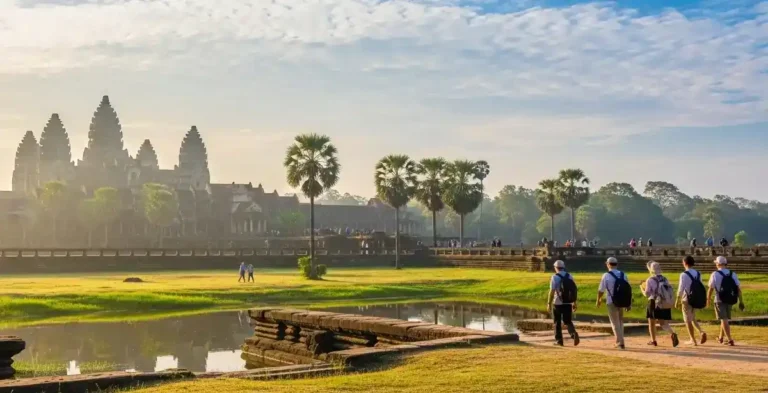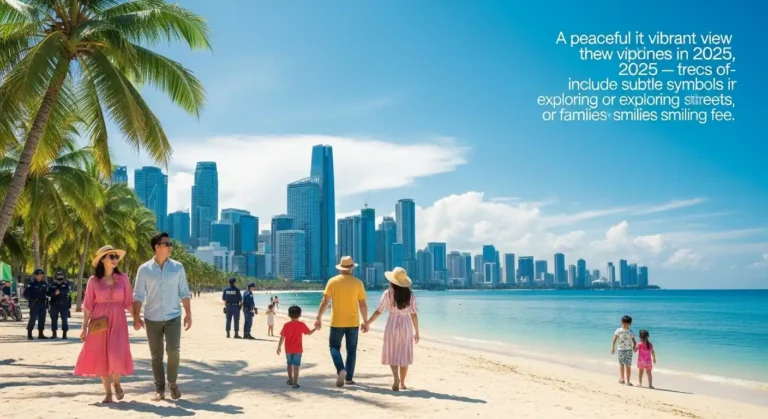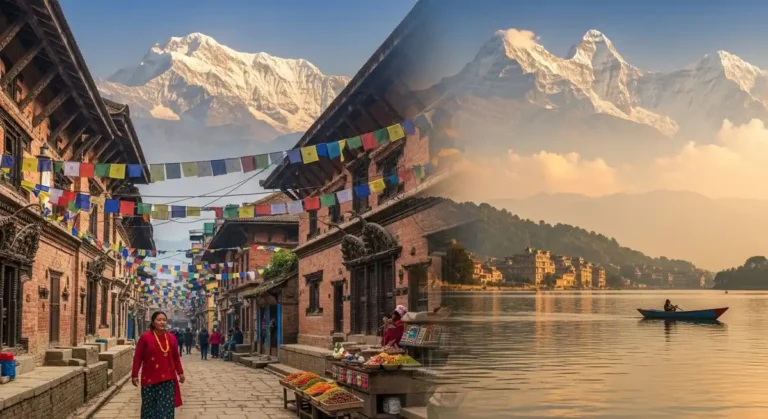Why Bardia National Park Is the Best Safari Destination in Nepal?
Bardia National Park is a peaceful and wildlife-rich destination in western Nepal, known for its tigers, rhinos, and untouched natural beauty.
It offers jungle safaris, walking tours, and river adventures, making it one of the best places for nature lovers and adventure seekers.
Bardia National Park is a protected area in the Western Terai of Nepal. It covers 968 km² and is the country’s largest and most undisturbed national park.
- Top Wildlife Destination: Largest and most pristine national park in Nepal’s Terai; home to Bengal tigers, rhinos, elephants, and 400+ bird species.
- Exciting Safari Options: Choose from jeep, walking, elephant, or river safaris led by expert guides for immersive wildlife experiences.
- Affordable Entry: Entry fee per day – NPR 1,500 (foreigners), NPR 750 (SAARC), NPR 100 (Nepali); kids under 10 enter free.
- Easy Travel Access: Reach Bardia via flight to Nepalgunj + road transfer, long-distance bus, or cross-border drive from India.
- Best Time to Visit: February to April offers clearer views of wildlife due to short grass and dry weather.
- Rich Wildlife & Nature: Spot tigers, rhinos, elephants, dolphins, crocodiles, and many birds in varied landscapes like grasslands and sal forests.
- Beyond Safaris: Enjoy birdwatching, cultural tours with Tharu people, jungle walks, rafting, photography, and sunset views.
- Tour Costs & Packages: 3–5 day safari packages range from US$550–1100; jeep safaris cost US$200–250 (shared).
- What to Pack: Neutral clothes, sun protection, walking shoes, insect repellent, binoculars, rain gear, and first-aid essentials.
- Mandatory Guide Rule: All park visitors must hire a licensed guide for safety and responsible wildlife viewing.
- Sustainable Tourism Focus: Strong emphasis on eco-tourism, local community support, and wildlife conservation practices.
- Safety Tips: Book early, follow your guide, avoid risky wildlife contact, pack smart, stay hydrated, and respect local customs.
The park is home to over 61 mammals, including tigers, Rhinos, and elephants, along with 513 bird species, 120 fish, and 42 herpetofauna.
The area includes sal forest, grasslands, and alluvial washes, creating the perfect habitat for wildlife.
The park was established in 1988, evolving from the earlier Karnali Wildlife Reserve (1976) and Bardiya Wildlife Reserve (1984).
It is part of the Tiger Conservation Unit with Banke National Park, together covering 2,231 km² of rich biodiversity.
The Babai valley and Karnali River flow through the park, adding to its beauty and supporting rare species like the Gangetic dolphin.
Visitors can enjoy walking safaris, elephant rides, and peaceful rafting through the park’s untouched wilderness.
Its remote location has helped preserve the natural resources, and the surrounding buffer zone is co-managed with local communities to support community development and sustainable tourism.
Bardia National Park is a rare gem beyond the Himalayas, offering a close-to-nature experience away from the crowds.
Quick Facts About Bardia National Park
Bardia National Park in Nepal is the largest and most pristine national park in the Terai region. It is home to Bengal tigers, one-horned rhinoceros, elephants, and over 400 species of birds.
Established in 1988, it spans 968 sq km and offers rich wildlife, scenic forests, and exciting jungle safaris.
Quick Facts About Bardia National Park
- Location: Western Terai region, Nepal
- Established: 1988 (originally as Royal Bardia National Park)
- Area: 968 sq km (374 sq miles)
- Main Habitats: Sal forests, grasslands, savannahs, and riverine forests
- Entry Fee: Rs. 1,500 per day; separate ticket needed for each day
Wildlife You Can Spot
- Big Mammals: Bengal tiger, one-horned rhinoceros, Asian elephant
- Other Species: Swamp deer, wild water buffalo, sloth bears, leopards
- Primates & Deer: Langur monkeys, barking deer, spotted deer
- Aquatic Life: Gangetic dolphins, gharial crocodiles
- Birds: Over 400 bird species for birdwatching lovers
Best Time to Visit
- Ideal Months: February to April
- Why: Shorter grass gives better visibility to spot animals
- Tip: Carry sunscreen, sun hats, and water for hot days
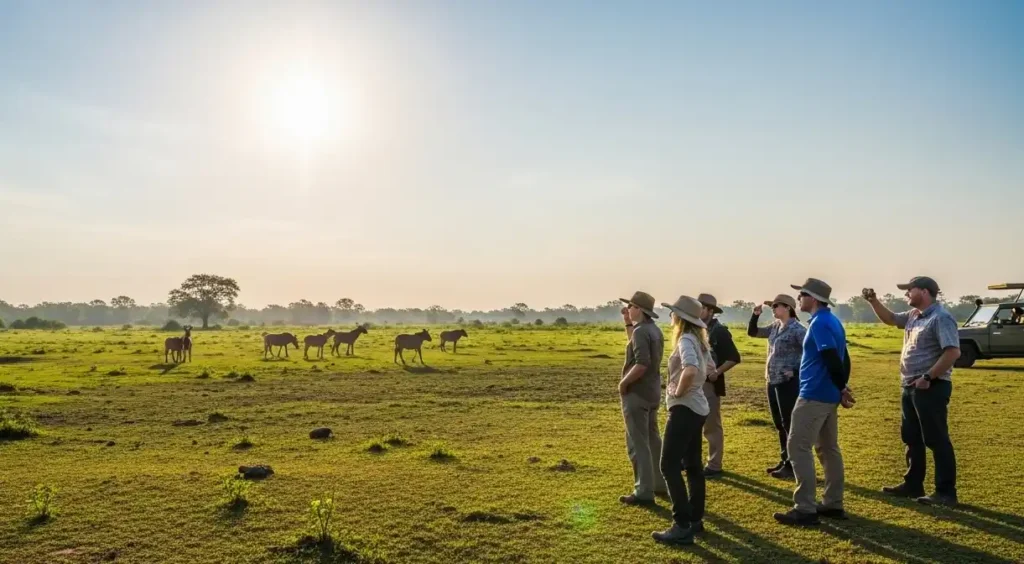
Things to Do
- Activities: Jungle safaris, bird watching, rafting
- Culture: Enjoy authentic cultural experiences with the Tharu people
- Conservation: Part of the Tiger Conservation Unit (TCU Bardia-Banke), connected to Banke National Park
Bardia National Park is a peaceful yet thrilling escape into Nepal’s wild side, perfect for nature lovers and wildlife enthusiasts alike.
How to Reach Bardia National Park (2025 Travel Options)
To reach Bardia National Park in 2025, travelers can take a domestic flight from Kathmandu to Nepalgunj, followed by a drive to Ambassa, or choose a direct long-distance bus from Kathmandu or Pokhara.
Visitors from India can enter Nepal via the Banbassa or Mahendranagar border and drive to the park. Each route offers scenic views and flexible travel options for all budgets.
✈️ By Flight: Fast and Comfortable
The fastest way to reach Bardia National Park is by taking a domestic flight from Kathmandu (Tribhuvan International Airport – KTM) to Nepalgunj Airport (KEP).
The flight takes about 45–50 minutes and is operated by reputable airlines like Buddha Air and Yeti Airlines with daily flights.
After landing at Nepalgunj, you can book a private jeep or car through your lodge for a direct ride to Ambassa, the gateway town near the park.
The road journey takes about 2.5 to 3 hours (74–90 km), offering a comfortable journey with scenic Nepalese landscapes.
For those seeking a budget-friendly option, local buses are available outside the airport.
These take 2–3 hours to reach Ambassa, and from there, a tuktuk or arranged pickup can bring you to Thakurdwara, the village next to the park.
🚌 By Bus: Budget-Friendly and Scenic
If you prefer slow travel and authentic local experiences, long-distance buses run from Kathmandu and Pokhara to Ambassa.
The buses depart from Gongabu Bus Station (New Bus Park) in Kathmandu, with afternoon departure times between 1:00 PM to 5:00 PM.
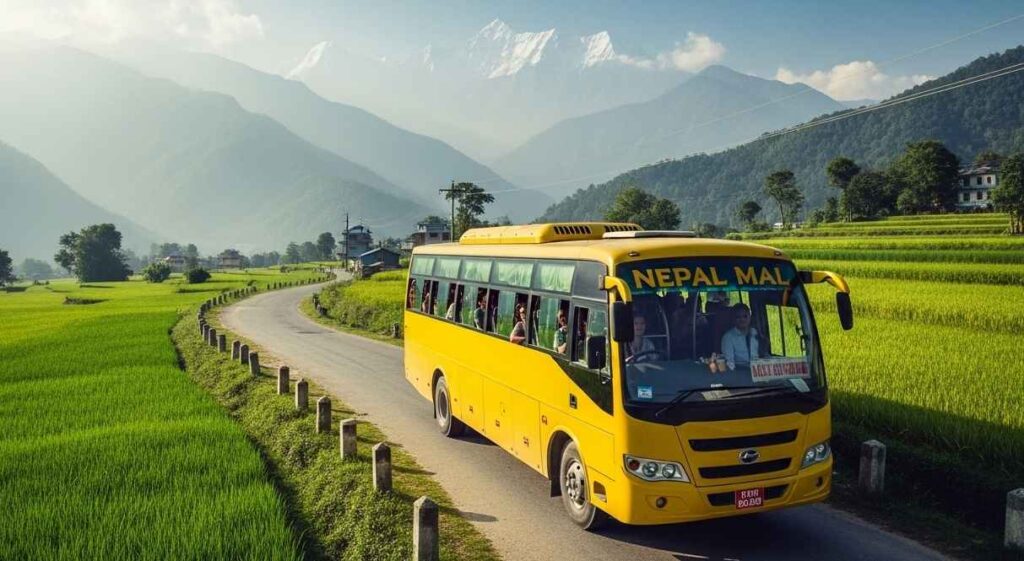
- Kathmandu to Ambassa takes about 16–18 hours
- Pokhara to Ambassa takes about 12–14 hours
- Ticket price ranges from NPR 2,500 to NPR 2,700 (around $18–$20)
Look for bus companies like Sudurpaschim Yatayat and Mahakali Yatayat offering sofa or AC buses for more comfort. The ride passes through beautiful landscapes, and buses generally arrive in Ambassa by early morning.
From Ambassa, Thakurdwara is 13–15 km away. A tuktuk ride costs about NPR 500, or you can arrange a stress-free transfer with your eco-lodge like Wild Planet Eco Retreat.
🚗 From India: Cross-Border Drive
Travelers coming from India can drive from India and enter Nepal via the Banbassa or Mahendranagar border crossing. From there, it’s easy to travel to Ambassa and onwards to Bardia National Park.
The roads on the Nepalese side are suitable for driving, offering an adventure route and a chance to experience local culture.
This is a great option for those exploring the rural area between India and Nepal or combining multiple destinations on one trip.
Each of these transportation methods offers a flexible way to explore one of Nepal’s most beautiful natural areas. Whether you’re short on time or traveling on a budget, there’s a travel route for everyone to reach this incredible jungle area.
Types of Safaris in Bardia National Park
Types of Safaris in Bardia National Park include Jeep safaris, Walking safaris, Elephant safaris, and River safaris.
Each offers a unique way to explore the park’s rich wildlife and diverse landscapes, from jungle trails to peaceful rivers, guided by experienced locals.
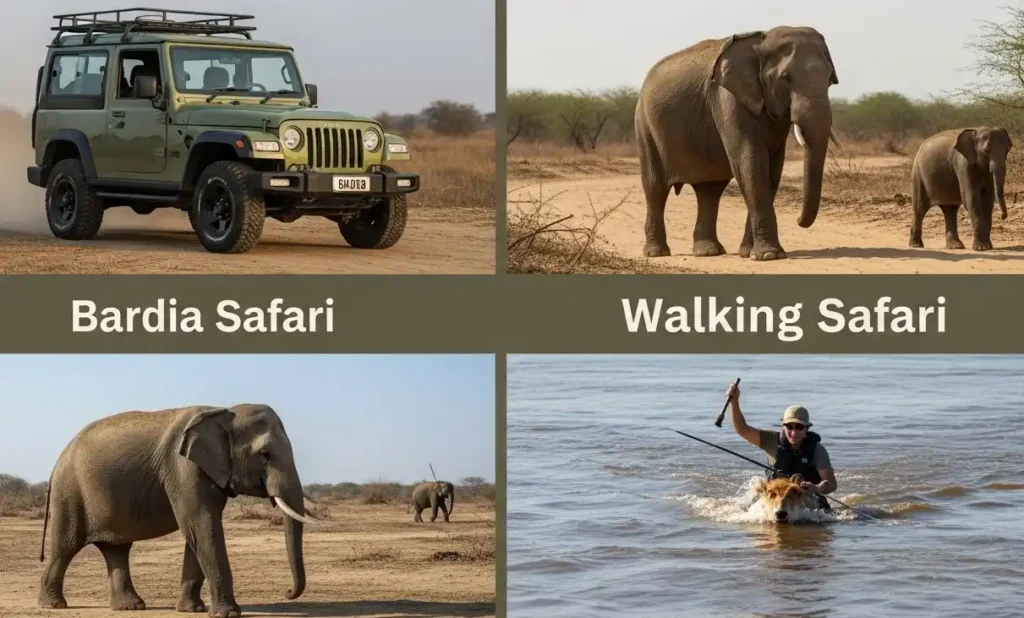
Jeep Safari
A Jeep Safari is one of the most popular ways to explore Bardia National Park. It lets visitors cover more ground and venture deep into the jungle, increasing chances to spot majestic wildlife like tigers, rhinos, and wild elephants.
Safaris can be booked for a half day, full day, or even multi-day excursions.
A full-day jeep safari typically costs USD 200–250, which can be shared among guests. Most hotels arrange jeep safaris and help pair travelers to reduce individual costs.
Walking Safari
The Walking Safari is perfect for nature lovers who want a slower, more immersive experience.
Led by expert guides, these safaris take you through forest trails, letting you observe birdlife, track animal movements, and explore smaller ecosystems on foot.
A full-day walking safari costs around USD 50, including the entry fee (Rs 1,500) and a packed lunch.
Elephant Safari
For a unique vantage point, the Elephant Safari offers a magical way to view wildlife from the back of a trained elephant.
This type of safari allows for close, yet respectful, encounters with animals in their natural habitat.
Riding atop an elephant provides a quiet, elevated experience through the jungle, especially suitable for spotting animals hidden in the tall grass.
River Safari
A River Safari is a peaceful and scenic experience, often conducted in a wooden canoe or small boat.
It allows visitors to float along the waterways of Bardia, taking in the serene environment and watching for aquatic wildlife such as crocodiles, birds, and river dolphins. It’s a relaxing way to explore the park from a different angle.
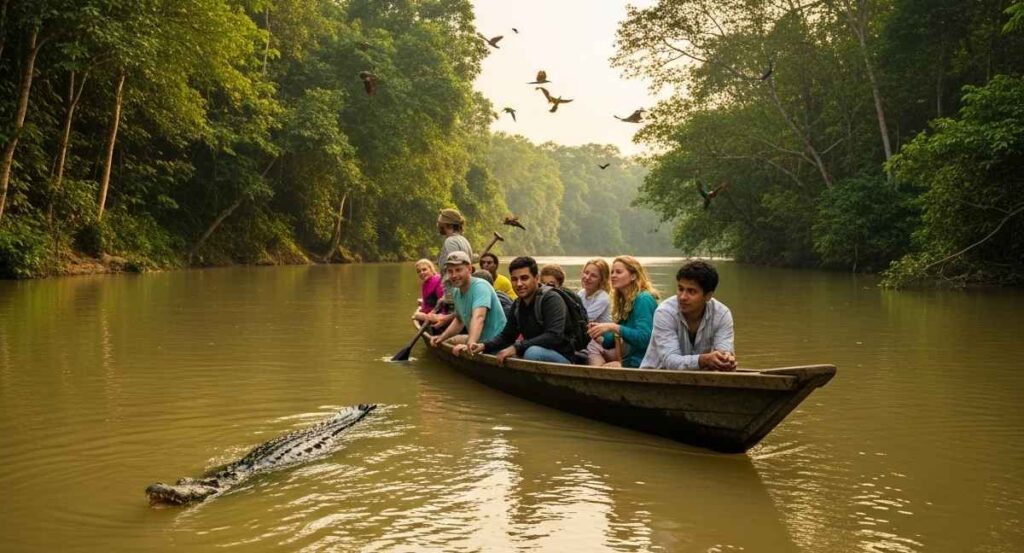
These safari options offer an excellent mix of adventure, learning, and wildlife viewing. Whether you’re walking through the jungle, riding a jeep, sitting atop an elephant, or cruising the river, Bardia offers unforgettable safari experiences.
Wildlife in Bardia National Park
Bardia National Park is one of Nepal’s finest destinations for seeing wildlife in its natural habitat. It is home to royal Bengal tigers, making it one of the best places in Asia to spot these majestic creatures in the wild.
The park’s dense jungles, savannah, and riverine forest provide perfect cover and hunting grounds for these big cats.
Visitors often encounter Asian wild elephants, including the famous Rasa Gauge, and the one-horned rhinoceros.
The Gangetic dolphin can be spotted during rafting on the river, while crocodiles are often seen sunbathing along the banks.
Bardia is also known for its variety of deer species, wild boars, and playful monkeys. With 53 types of mammals, 25 types of reptiles, and 121 types of fish, the park is incredibly diverse.
Bird lovers can enjoy watching resident and migratory birds, with over 400 species of birds, including 6 protected birds.
The park covers a protected area with 839 varieties of plants and more than 642 species of animals, making it a true sanctuary for rare species and unforgettable mammal encounters.
Whether walking through its rich vegetation or enjoying a calm rafting trip, Bardia offers a peaceful and thrilling wildlife experience year-round.
Other Best Things to Do in Bardia (Beyond Safari)
Best things to do in Bardia include birdwatching, jungle walks, cultural tours, rafting on the Karnali River, visiting the Crocodile Breeding Center, and exploring local Tharu villages.
These unique activities offer peaceful nature experiences, cultural connections, and adventure beyond wildlife safaris.
Sunset at Thakurdwara
Enjoy a beautiful sunset view from the open field near the river in Thakurdwara, close to the Elephant Breeding Centre.
It’s a quiet place where the sky turns golden as the sun sets across Bardia National Park. It’s the perfect spot to relax and enjoy the peaceful scenery.
Birdwatching in the Wild
Bardia is a bird lover’s paradise. With over 400 bird species, the park is filled with colorful birds and a rich bird habitat. Bring your binoculars and enjoy wildlife spotting early in the morning.
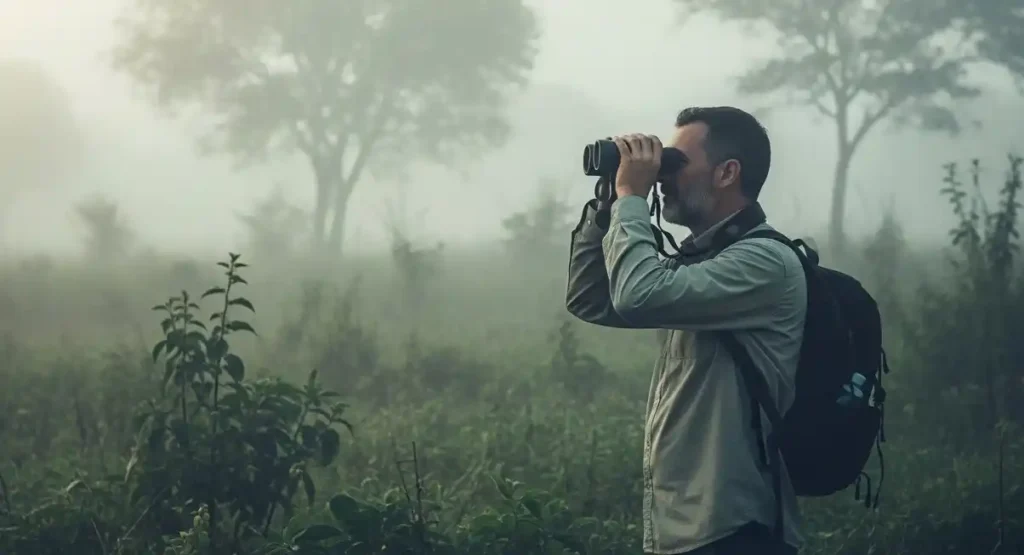
If you want to explore more, visit the Koshi Tappu Wildlife Reserve—a top place for unique birds in Nepal.
Go on a Jungle Walk
Take a peaceful jungle walk or foot safari through the wilderness of Bardia. These walks let you feel the sound of jungle, enjoy close-up views of nature, and learn about different species in their natural homes.
You can join half-day or full-day jungle walk experiences with expert guides for a memorable sightseeing tour.
Experience Tharu Culture
Explore the vibrant culture of the Tharu ethnic group in the Tarai Region. Join a cultural tour or walk through villages to see traditional Tharu houses, traditional dresses, and taste traditional food.
Enjoy dance performances and learn about their rich ethnic tradition, daily local life, and cultural experience.
Rafting Adventures
Try white-water rafting in the mighty Karnali River or gentle floats in the Babai River. The rapids offer excitement for thrill seekers and amazing river views with chances to see wildlife along the riverbanks. These rafting adventures are popular among travelers who love adventure and nature.
Visit the Crocodile Breeding Center
Learn about conservation at the Crocodile Breeding Center near Bardia. This breeding centre is home to endangered gharial and mugger crocodiles.
It’s a great place for families and kids to explore and understand how Nepal protects its rare animals.
Capture Bardia Through the Lens
If you love nature photography, Bardia is a dream. From sunsets to birds and local Tharu people, every moment is worth capturing.
The changing light, jungle, and wildlife make it perfect for creating beautiful memories.
Bardia Safari Cost & Entry Fees (2025)
In 2025, Bardia safari packages offer flexible pricing options for every type of traveler. The most popular 3-night/4-day safari package typically ranges from US$550 to US$1100 per person. For 4-night/5-day tours, prices usually start from US$995 per person.
Tour operators often include the entry fee and park permit in the package, eliminating the need for separate payments.
For those booking solo or in small groups (2–4 people), costs may be slightly higher than for larger groups of 11–15 travelers, who benefit from better per-person rates.
Factors That Influence Safari Pricing
Several elements impact the overall cost of a Bardia safari experience:
- Group Size: Larger groups get lower per-person cost
- Accommodation Type: Choosing luxury options raises the total price
- Included Activities: Adventures like jeep safari, jungle walks, and canoeing add value
- Tour Operator: Each operator has unique package styles and prices
- Nationality Discounts: Some operators offer special rates for Indian or Bangladeshi guests
Entry Fees and Walking Safari Costs
The Bardia National Park entry fee is about Rs. 1,500 (1500 NPR) and is usually included in your tour package.
For independent activities, a full-day walking safari costs around USD 50 and includes a packed lunch and the park fee. Half-day options are also available and can be paired with a jeep safari in the afternoon.
Example Safari Package Pricing
Here’s a quick look at real examples from trusted operators like Gokyo Treks Nepal:
- 1 person: ~US$850 (3-night/4-day)
- 2–4 people: ~US$795–800 per person
- 4–6 people: ~US$700 per person
- 3–6 people: ~US$775 per person
Jeep safari costs between USD 200–250 for a full day, and the cost can be split among passengers. Your hotel can help arrange the ride or pair you with other guests to share expenses
Tips to Get the Best Deals
- Compare prices from multiple tour operators
- Book in advance to secure lower rates
- Inquire about discounts for students or other groups
- Travel in larger groups to reduce cost per person
Bardia in 2025 promises a rich safari adventure with affordable options tailored to different preferences.
What to Pack for a Bardia Safari in 2025
Pack light, breathable clothes in natural colors, sturdy walking shoes, sun protection, insect repellent, binoculars, and a camera.
Don’t forget medications, a first-aid kit, and a light jacket for cooler mornings or evenings. Add rain gear, water bottles, and travel essentials for a safe and enjoyable safari.
Clothing for Comfort and Safety
Wear lightweight, breathable clothing like t-shirts, shorts, and loose pants for Bardia’s warm, humid climate. Choose neutral colours like khaki, green, or light brown to blend into the jungle.
Long sleeves and pants protect from sunburn, mosquitoes, and thorny plants. Add a fleece or sweater for cool evenings, especially in spring or monsoon season.
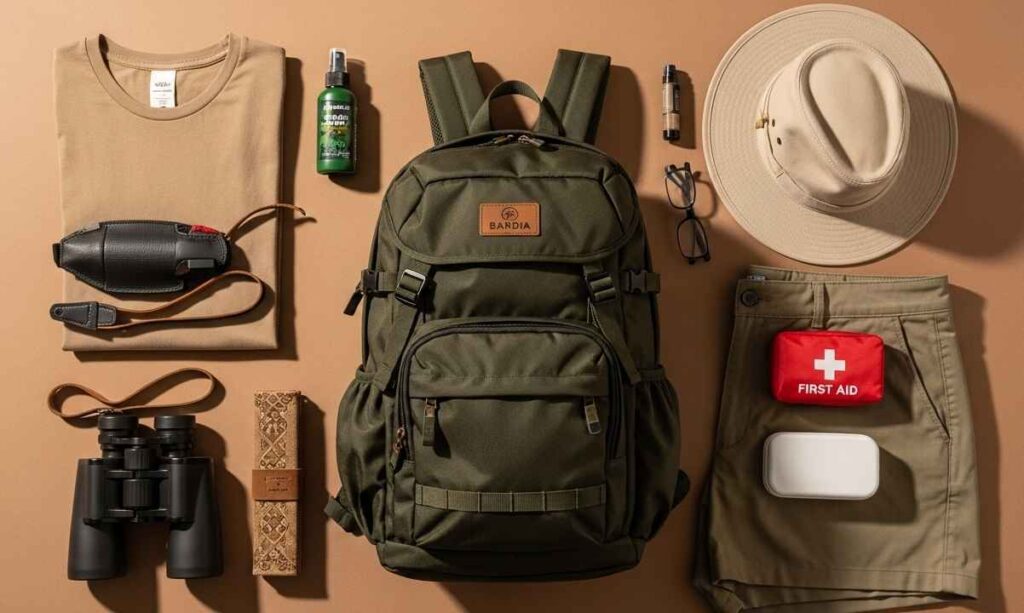
Footwear for Jungle Terrain
Use closed-toe walking shoes or hiking boots with a good grip. These help you move safely over uneven terrain and forest paths.
Protection from Sun and Insects
Carry sunscreen, a wide-brimmed hat or sun hat, and sunglasses to guard against strong sunlight. Use insect repellent to stay safe from mosquitoes and jungle insects.
Essentials for Safari
Pack a binocular for wildlife spotting and a camera with a good lens to capture the amazing views. Bring a day pack to hold water bottles, snacks, and your personal items during full-day walks.
A flashlight, headlamp, or headlight is useful for early morning or evening walks.
Toiletries and First Aid
Include basic toiletries like soap, shampoo, toothpaste, and a quick-drying towel. Bring a first-aid kit with pain relievers, antibacterial wipes, antiseptic, and your prescription medications.
Optional but Useful Items
Add a rain jacket or waterproof poncho for the monsoon season. If staying in basic accommodations, pack a sleeping bag, sleeping pad, or small lock.
Swimwear is a great extra if your lodge has a pool. Don’t forget your passport, travel documents, and some cash for small purchases or tips.
Is It Mandatory to Hire a Guide in Bardia?
Yes, it is mandatory to hire a guide to enter Bardia National Park. All visitors must be accompanied by a licensed guide for any jungle safari or activity inside the park.
Hiring a guide in Bardia National Park is a required part of the experience and helps ensure your safety and a better understanding of the wildlife and environment.
Whether you’re planning a jungle walk, jeep safari, or other excursions, a guide will be with you to lead the way.
Most travelers book their guided safari through their hotel or accommodation, which makes things easy. While there are no travel agencies in Thakurdwara like in Chitwan, it’s common to speak with your lodge directly.
You may be able to find budget-friendly options or get a discount if you call ahead or negotiate at your place of stay.
The park also requires an entrance fee, and this, along with the guide, can often be arranged as a package.
Several travel websites suggest booking your activities once you arrive, as same-day arrangements are possible in many hotels.
Local Language & Wildlife Terms
Local Language & Wildlife Terms in Bardia include the Tharu dialect spoken by indigenous communities and names of diverse wildlife such as the Royal Bengal Tiger, Greater One-horned Rhinoceros, wild elephants, monkeys, and Gangetic Dolphins found in the park.
Bardia, located in western Nepal, is home to the Tharu people, the indigenous community deeply connected to the land.
They speak the Tharu language, which has a unique dialect different from other regions like Chitwan.
Their culture, shaped by nature and daily life in Bardia, reflects a strong bond with the environment and wildlife.
The park is rich in animal diversity. It’s known for the Royal Bengal Tiger, Greater One-horned Rhinoceros, and wild elephants.
Visitors may also encounter leopards, sloth bears, swamp deer, and various monkey species.
Over 400 bird species like kingfishers, eagles, and hornbills fill the skies. The rivers host reptiles such as the gharial, marsh mugger crocodiles, and sometimes the rare Gangetic Dolphin.
Through community-based efforts and strong collaboration with local communities, conservation programs continue to protect these endangered species, making Bardia a true success story in Nepal.
3 to 5-Day Suggested Itinerary for Bardia National Park
A 3 to 5-day itinerary in Bardia National Park offers the perfect mix of jungle safaris, cultural experiences, birdwatching, and wildlife exploration.
Start with a flight from Kathmandu to Nepalgunj, followed by a scenic drive to Bardia. Spend your days with jungle walks, jeep safaris, Tharu village visits, and serene moments along the Karnali River.
Day 1: Welcome to Bardia
Fly from Kathmandu to Nepalgunj (1 hour), then enjoy a peaceful 2-hour drive to Bardia National Park. Check into your jungle lodge or resort.
In the afternoon, visit a nearby Tharu village to learn about local culture and traditions.
Stop by the Bardia visitor center and crocodile breeding center. End the day with a warm dinner and a brief wildlife talk at your lodge.
Day 2: Jungle Walk & Wildlife Adventure
Begin your day with a full-day jungle walk guided by a professional naturalist and porter. Spot incredible animals like rhinos, elephants, and even the majestic Bengal tiger.
Enjoy a picnic lunch in the forest and explore the Karnali River region, known for birdwatching. Share stories of your sightings over dinner in the evening.
Day 3: Safari & Tharu Culture
Start the morning with an exciting jeep safari through the park. Keep your eyes open for more wildlife, especially the elusive Royal Bengal tiger.
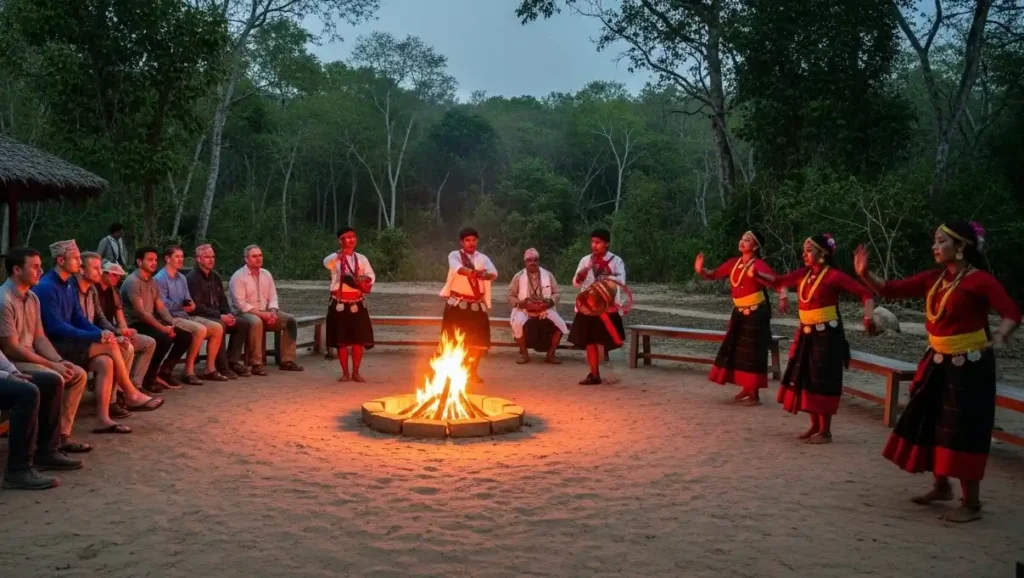
In the afternoon, enjoy peaceful birdwatching and explore the park’s beautiful landscapes.
Return to your accommodation for a vibrant cultural dance performance by the local Tharu people, followed by dinner and a wildlife discussion.
Day 4 (Optional): River Life & Local Encounters
Take a calm canoe ride on the Karnali River, an excellent way to spot aquatic animals and birds. Later, choose between another jungle walk or a second jeep safari.
In the evening, enjoy another cultural program or visit a different Tharu village for a deeper understanding of local life.
Day 5: Final Safari & Departure
Start your day early with a last birdwatching tour before breakfast. Then, drive back to Nepalgunj for your flight to Kathmandu, bringing your unforgettable Bardia experience to a close.
Responsible & Sustainable Tourism in Bardia
Responsible & Sustainable Tourism in Bardia supports local communities, protects wildlife, and ensures long-term care for nature and culture through ethical, low-impact travel practices.
Community-Based Travel and Local Support
Responsible & sustainable tourism in Bardia is built on community involvement. Visitors stay in homestays run by local families, offering a genuine look into Tharu culture.
These cultural experiences not only preserve Tharu traditions but also support the local economy.
By participating in community-based tourism, travelers help create sustainable livelihoods for local communities.
Ethical Nature & Wildlife Conservation
Tourism in Bardia avoids animal-related activities like elephant safaris. Instead, it promotes nature-based tourism through quiet nature walks and guided tours that focus on wildlife observation.
These responsible practices ensure minimal disturbance to wildlife and protect their habitats. Organizations like Responsible Treks prioritize animal welfare and promote ethical tourism.
Environmental and Economic Balance
Efforts in environmental conservation are strong in Bardia. Programs like the Bardia Conservation Program support biodiversity research, sustainable agriculture, and long-term ecosystem health.
Tourists are encouraged to support local businesses, use local services, and buy local goods, strengthening sustainable development and boosting economic benefits.
Forward-Looking and Regenerative
Bardia is moving beyond just sustainable tourism. There’s a growing focus on regenerative tourism, which actively helps in environmental restoration and community improvement.
It aims to enhance both ecosystem well-being and cultural richness, making Bardia a sustainable destination for the future.
Bardia National Park Ticket Price
The entry ticket for Bardia National Park is affordable and clearly categorized. Prices are set fairly for different visitors based on their nationality.
Entry Fees (Per Person, Per Day):
- Foreigners: NRs. 1,500
- SAARC Nationals: NRs. 750
- Nepali Citizens: NRs. 100
- Children under 10 years: Free
These prices apply per day, making it easy to plan your visit based on your stay duration. Children below 10 enjoy free access, making it family-friendly and budget-conscious for local and international travelers alike.
Safety Tips for Visiting Bardia (2025)
To stay safe and enjoy your trip to Bardia in 2025, plan ahead, follow local guidance, stay prepared for nature and weather, and respect the wildlife and local culture.
- Book in advance: Secure your safari, accommodation, and travel plans, especially during October to April (peak season), to avoid last-minute hassle.
- Follow your guide: Whether on jeep safaris or jungle walks, always follow your guide’s instructions, keep silent, and avoid sudden movements near animals.
- Maintain distance: Keep a safe distance during wildlife sightings, especially with tigers, bears, and crocodiles, for your safety and theirs.
- Dress smart: Wear comfortable, neutral-colored clothing, long pants, and sturdy shoes for scratch protection and to avoid ticks.
- Pack essentials: Bring a basic first-aid kit, bear spray, and insect repellent, especially if you’re going during monsoon season.
- Stay hydrated: Use a reusable water bottle and refill water regularly with purified water, especially during warmer months.
- Eat safely: Choose reputable establishments, avoid undercooked food, and drink only bottled or purified water to ensure food safety.
- Be health-ready: Consult a doctor before travel for vaccinations like hepatitis A, hepatitis B, typhoid, rabies, flu, MMR, DTaP, polio, and varicella.
- Plan for altitude: If trekking in higher altitudes, be mindful of altitude sickness and carry altitude medication if recommended.
- Travel smart: Get travel insurance to cover medical expenses, theft, or lost luggage, and stay updated on travel advisories.
- Respect local culture: Use a few basic Nepali phrases, follow village customs, and support eco-friendly practices like avoiding single-use plastics.
- Watch the weather: Pack for changing weather conditions, especially during the rainy season or monsoon, and be prepared for outdoor activities.
These tips will help ensure your trip to Bardia in 2025 is both safe and unforgettable.
Conclusion
Bardia National Park is one of the best places in Nepal to experience wildlife safaris, spot tigers in the wild, and enjoy peaceful nature far from busy cities like Kathmandu.
Bardia National Park offers a true jungle adventure. Located in western Nepal, it is known for being rich in wildlife and is especially famous for its tigers. Visitors often say they have more chance to spot tigers in Bardia than in other parks like Chitwan.
The park is a top choice for those wanting to see wildlife in Nepal. You can enjoy a real wildlife safari in natural surroundings. If you plan to stay for 4-5 days, the experience becomes even better.
It’s a peaceful place, far away from the crowds. The park is quiet, beautiful, and gives a true feel of nature. For nature lovers and wildlife explorers, it’s truly worth to go and is considered one of the best parks in Nepal.
FAQs: Bardia National Park, Nepal (2025)
What is Bardiya National Park known for?
Bardiya National Park is known for its tigers, rhinos, and wild elephants. It has thick forests, rivers, and open grasslands. The park is quiet and full of wildlife. Many people visit to see rare animals in nature.
Is Bardia National Park worth visiting?
Yes, Bardia National Park is worth visiting. You can go on jungle safaris, walk in the forest, and float on rivers. It’s calm, clean, and full of animals. You can also meet the Tharu people and learn about their culture.
Which is better, Chitwan or Bardiya?
Bardia is better for those who love quiet and real jungle adventures. It has fewer tourists than Chitwan. You get a better chance to see tigers and rhinos in the wild. It feels peaceful and close to nature.
What is there to do in Bardia National Park?
In Bardia, you can go on jeep safaris, walk in the jungle, and watch birds. You can raft on the river and visit Tharu villages. Don’t miss sunset views, cultural shows, and the crocodile center. Every day brings something new to enjoy.
In which district Bardiya lies?
Bardiya lies in the Bardiya District of western Nepal. It is part of the Terai region and is near the Karnali River. The main village near the park is Thakurdwara.
Where is Rara Lake located?
Rara Lake is located in the Mugu District of northwestern Nepal. It is the biggest lake in Nepal. The lake sits in the mountains and is part of Rara National Park.
What animals are in Bardia National Park?
Bardia has Bengal tigers, rhinos, elephants, and crocodiles. You can also see deer, monkeys, dolphins, and many birds. The park is home to more than 600 types of animals and over 400 bird species.
How much does it cost to go to Bardia Safari?
The Bardia safari cost depends on your tour.
- Entry Fee: Rs. 1,500 per person per day
- Jeep Safari: USD 200–250 per day (can be shared)
- Walking Safari: Around USD 50 (includes lunch and entry)
Tour packages for 3–5 days cost from USD 550 to 1100, depending on group size and hotel type.
When to visit Bardiya National Park?
The best time to visit Bardia is from February to April. The weather is dry, and grass is short, so it’s easier to see animals. Mornings are cool, and days are sunny. This time is great for safaris and jungle walks.
Disclaimer
This guide is for informational purposes only. Wildlife sightings and tour experiences may vary based on weather and seasonal changes. Prices mentioned are based on current estimates as of 2025. For bookings or exact updates, check with local operators. TravelDrizzle.com is not responsible for any personal arrangements or changes made during your trip. Always travel responsibly and follow local guidelines.


